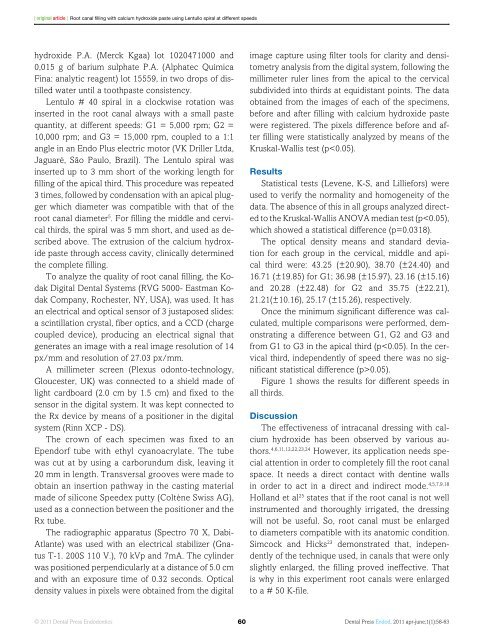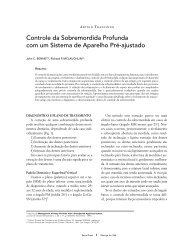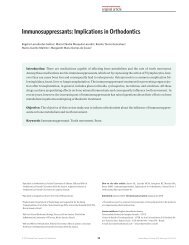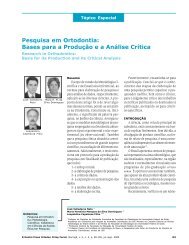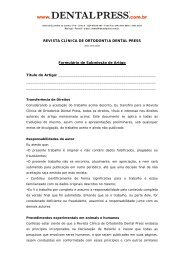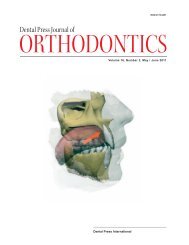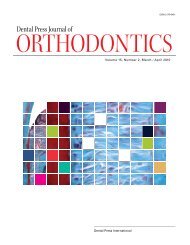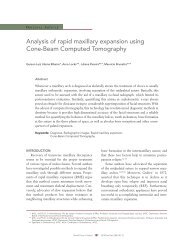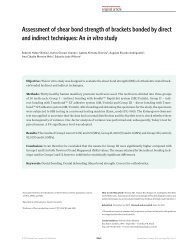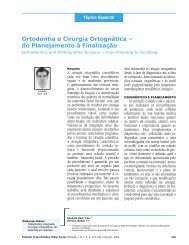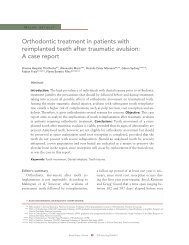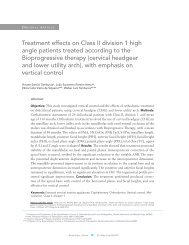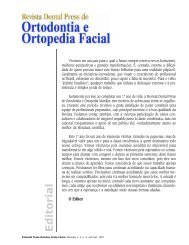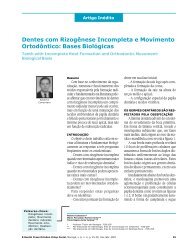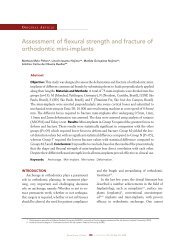Dental Press
Dental Press
Dental Press
Create successful ePaper yourself
Turn your PDF publications into a flip-book with our unique Google optimized e-Paper software.
[ original article ] Root canal filling with calcium hydroxide paste using Lentullo spiral at different speeds<br />
hydroxide P.A. (Merck Kgaa) lot 1020471000 and<br />
0,015 g of barium sulphate P.A. (Alphatec Química<br />
Fina: analytic reagent) lot 15559, in two drops of distilled<br />
water until a toothpaste consistency.<br />
Lentulo # 40 spiral in a clockwise rotation was<br />
inserted in the root canal always with a small paste<br />
quantity, at different speeds: G1 = 5,000 rpm; G2 =<br />
10,000 rpm; and G3 = 15,000 rpm, coupled to a 1:1<br />
angle in an Endo Plus electric motor (VK Driller Ltda,<br />
Jaguaré, São Paulo, Brazil). The Lentulo spiral was<br />
inserted up to 3 mm short of the working length for<br />
filling of the apical third. This procedure was repeated<br />
3 times, followed by condensation with an apical plugger<br />
which diameter was compatible with that of the<br />
root canal diameter 5 . For filling the middle and cervical<br />
thirds, the spiral was 5 mm short, and used as described<br />
above. The extrusion of the calcium hydroxide<br />
paste through access cavity, clinically determined<br />
the complete filling.<br />
To analyze the quality of root canal filling, the Kodak<br />
Digital <strong>Dental</strong> Systems (RVG 5000- Eastman Kodak<br />
Company, Rochester, NY, USA), was used. It has<br />
an electrical and optical sensor of 3 justaposed slides:<br />
a scintillation crystal, fiber optics, and a CCD (charge<br />
coupled device), producing an electrical signal that<br />
generates an image with a real image resolution of 14<br />
px/mm and resolution of 27.03 px/mm.<br />
A millimeter screen (Plexus odonto-technology,<br />
Gloucester, UK) was connected to a shield made of<br />
light cardboard (2.0 cm by 1.5 cm) and fixed to the<br />
sensor in the digital system. It was kept connected to<br />
the Rx device by means of a positioner in the digital<br />
system (Rinn XCP - DS).<br />
The crown of each specimen was fixed to an<br />
Ependorf tube with ethyl cyanoacrylate. The tube<br />
was cut at by using a carborundum disk, leaving it<br />
20 mm in length. Transversal grooves were made to<br />
obtain an insertion pathway in the casting material<br />
made of silicone Speedex putty (Coltène Swiss AG),<br />
used as a connection between the positioner and the<br />
Rx tube.<br />
The radiographic apparatus (Spectro 70 X, Dabi-<br />
Atlante) was used with an electrical stabilizer (Gnatus<br />
T-1. 200S 110 V.), 70 kVp and 7mA. The cylinder<br />
was positioned perpendicularly at a distance of 5.0 cm<br />
and with an exposure time of 0.32 seconds. Optical<br />
density values in pixels were obtained from the digital<br />
image capture using filter tools for clarity and densitometry<br />
analysis from the digital system, following the<br />
millimeter ruler lines from the apical to the cervical<br />
subdivided into thirds at equidistant points. The data<br />
obtained from the images of each of the specimens,<br />
before and after filling with calcium hydroxide paste<br />
were registered. The pixels difference before and after<br />
filling were statistically analyzed by means of the<br />
Kruskal-Wallis test (p


